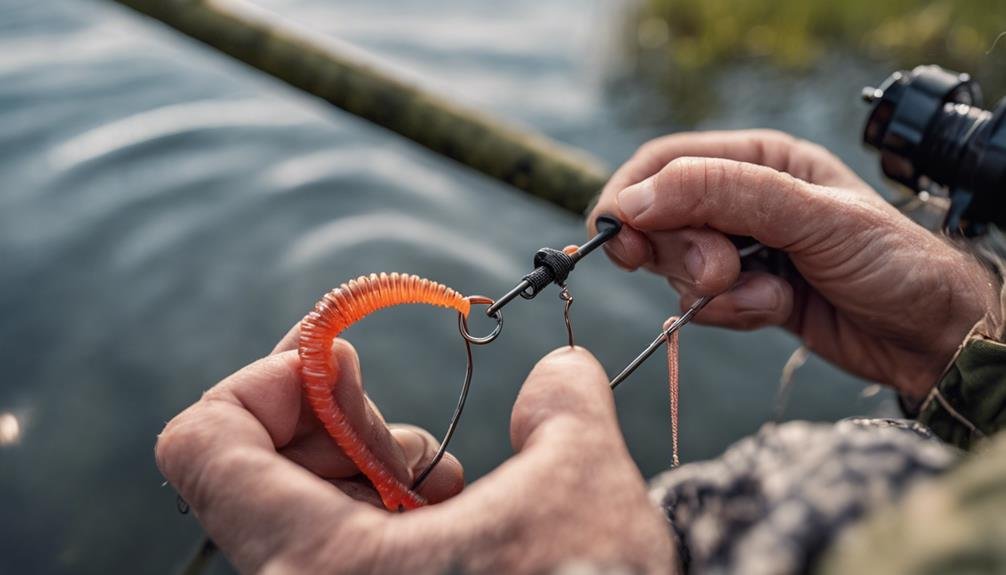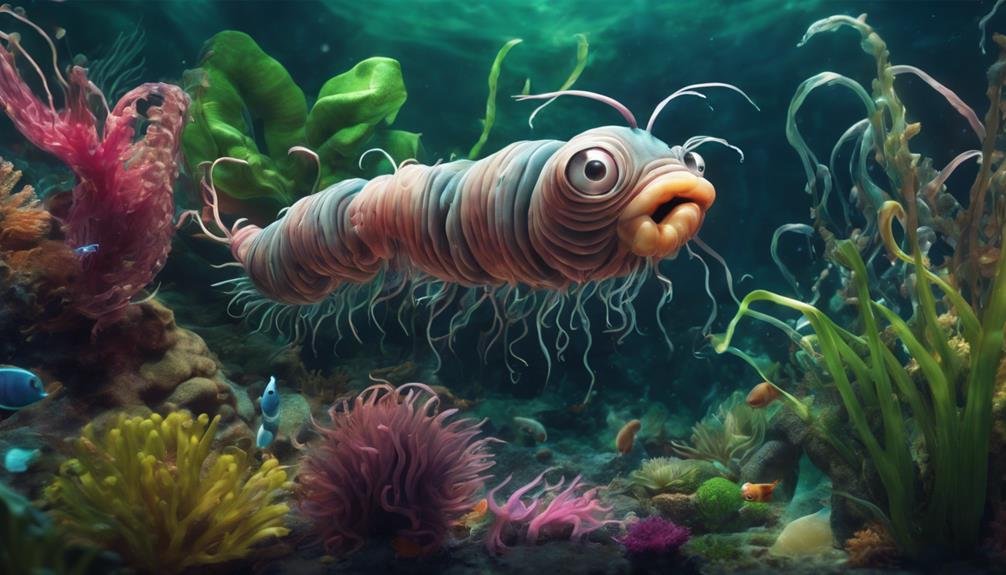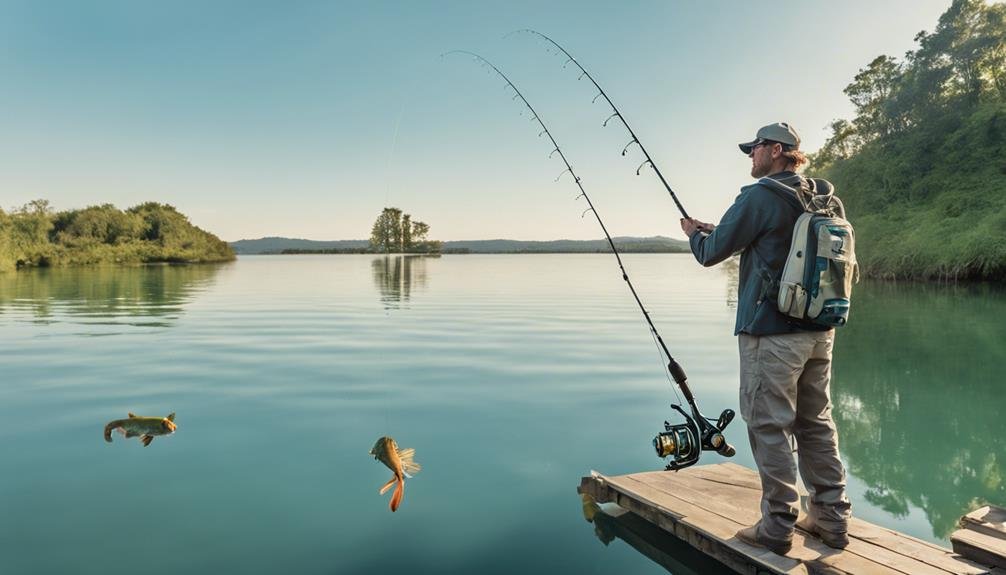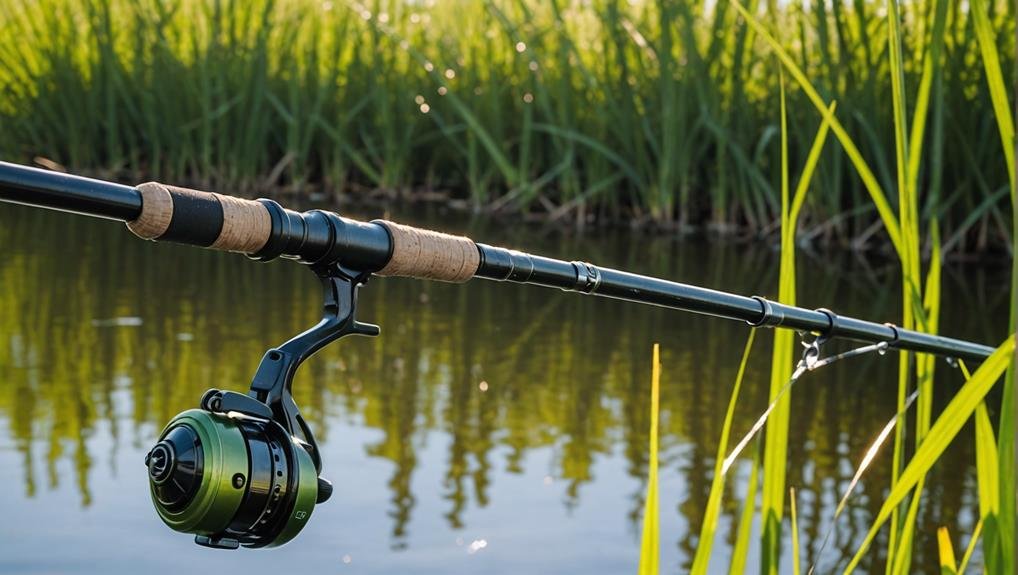When you’re looking to improve your finesse fishing game, the wacky rig offers a simple yet highly effective method. By rigging a soft plastic stick bait with an O-ring around the middle, you create an enticing shimmy that bass find irresistible. Whether targeting bass around dock pilings or casting near grass lines, the wacky rig’s versatility makes it a must-have in your tackle box. But how do you choose the right equipment and perfect your technique? There’s more to mastering the wacky rig and understanding its nuances can elevate your angling success.
Key Takeaways
- It is ideal for bass fishing in shallow waters near cover like grass lines and docks.
- Use a 7-foot spinning rod with an 8-10-pound fluorocarbon line for best results.
- Slide an O-ring onto the bait and thread the hook through it to enhance bait action.
- Experiment with soft plastics and tungsten nail weights to optimize fall speed.
- Effective during spawn and post-spawn periods, especially in clear water conditions.
How to Rig a Wacky Rig

Start by sliding an O-ring onto your stick bait using a rigging tool to rig a wacky rig. Position the O-ring in the middle of the stick bait to guarantee balance.
Next, thread your hook through the O-ring, ensuring it’s secure but not too tight. This setup is key to achieving the signature shimmy action that makes the wacky rig effective.
Now, tie your line to the hook using a Palomar knot. This knot is known for its strength and reliability, ensuring your hook stays firmly attached while you fish. The process should take less than 30 seconds, making it quick and efficient.
The wacky rig’s unique presentation is particularly enticing to bass, especially when fishing around cover like dock pilings, laydowns, and grass lines.
As it descends, the slow-sinking, shimmy action of the stick bait mimics the movement of a distressed baitfish, which bass find irresistible. Whether you’re targeting bass hiding in thick cover or those lurking along the edges of grass lines, the wacky rig offers an effective and simple solution to enhance your catch rate.
Choosing Wacky Rig Equipment
When selecting equipment for a wacky rig, begin with a 7-foot spinning rod paired with an 8-—to 10-pound fluorocarbon line for the finest results.
You’ll also require a short-shank, wide-gap wacky rig hook to guarantee peak performance.
Choose soft plastics like the Berkley PowerBait Fat Dover Crawler and adjust your tungsten nail weights according to water depth and desired fall speed.
Essential Rod and Reel
Choosing the right rod and reel for wacky rig fishing can make all the difference in your angling success. Start with a 7-foot spinning rod, which pairs perfectly with an 8- or 10-pound fluorocarbon line. This combination provides the sensitivity you need to feel those subtle bites. A medium-action spinning rod gives you the flexibility to handle a variety of soft plastic baits, including the popular Berkley PowerBait Fat Dover Crawler.
Opt for a high-speed reel to get the most out of your wacky rig setup. Its quick retrieve rate helps you stay in control when a fish strikes. The right wacky rig hook is also vital—go for a short-shank, wide-gap hook to rig your baits and increase your hook-up ratio effectively. Experiment with different rod setups, lines, and baits to match the fishing conditions and fine-tune your approach.
| Component | Recommendation | Benefit |
|---|---|---|
| Rod | 7-foot medium action spinning rod | Versatility and sensitivity |
| Line | 8- or 10-pound fluorocarbon line | Better feel and stealth |
| Reel | High-speed reel | Faster retrieve and control |
Ideal Hook Selection
After selecting the appropriate rod and reel, the next step in optimizing your wacky rig setup is choosing the perfect hook.
You’ll want to use a short-shank, wide-gap, wacky rig hook. This design guarantees that the soft plastic bait has ample room to move naturally, increasing your chances of enticing a bite.
Match the hook size to the size of the soft plastic bait you’re using. Smaller baits require smaller hooks, while larger baits demand larger hooks for better effectiveness. The right hook size ensures the bait is presented correctly and enhances penetration and holding power, which is essential for effective hook sets.
Durable construction is another essential factor. Your hooks should withstand repeated use without bending or breaking, ensuring you’re always prepared for the next catch. Experimenting with different hook styles and sizes will help you find the best fit for your wacky rig setup. Some anglers prefer certain hook styles for their unique features, so don’t hesitate to try various options.
Effective Wacky Rig Techniques

To maximize the use of wacky rigging, focus on ideal fishing conditions during spawn and post-spawn periods, especially near grass lines and docks.
Use essential rigging tools like weighted worms and tungsten nail weights to target shallow and deep water.
Experiment with different weight sizes to find the perfect fall speed for catching lethargic bass in clear water.
Ideal Fishing Conditions
The wacky rig shines in specific fishing conditions, making it a go-to technique for many anglers. It excels in shallow water areas like grass lines, reed pockets, and docks, providing you with precise presentations that bass can’t resist. Clearwater enhances the performance of the wacky rig, allowing the bass to see the subtle shimmy action of the bait.
During the spawn and post-spawn periods, bass near cover are particularly vulnerable to this technique. Post-spawn bass, especially those in depths of 8 to 12 feet, exhibit lethargic behavior, making them prime targets for the wacky rig.
Experimenting with baits is key when you’re targeting bass in these conditions. Different soft plastics, hook sizes, and weights can significantly optimize the effectiveness of your wacky rig. Adjusting your setup based on the conditions will lead to more strikes, whether fishing in deep or shallow water areas.
The wacky rig’s ability to cater to varying water depths and bass behaviors makes it an incredibly versatile tool. So, next time you’re out on the water, remember these conditions to maximize your success and reel in that elusive bass.
Essential Rigging Tools
When targeting bass in ideal conditions, having the right tools for your wacky rig setup can make a difference. Utilizing wacky rigging tools like O-rings and specialized rigging tools can enhance your bait’s action and extend its life span. These tools allow a quick setup, often taking less than 30 seconds to rig. This efficiency means more time fishing and less time grappling with your gear.
O-rings are essential for sliding onto stick baits, preventing them from tearing and improving their longevity. They come in various colors and materials, including aluminum, plastic, and metal, allowing you to choose what best suits your needs. Here’s a quick comparison to help you decide:
| Attribute | Benefit |
|---|---|
| O-rings | Prolong bait life |
| Rigging tools | Ensure swift and efficient setup |
| Stick baits | Prevent ripping |
| Colors/Materials | Match your preferences |
Incorporating these wacky rigging tools into your fishing arsenal saves you time and effort and enhances your overall experience. You’ll be better prepared to catch that trophy bass by focusing on bait life and action.
Advanced Fishing Strategies
Mastering advanced fishing strategies with a wacky rig can enhance your bass-catching success. This technique can be used during spawn and post-spawn periods. Bass are more aggressive and easier to catch in shallow areas like grass lines, reed pockets, and docks. Using a wacky rig in clear water can improve your presentation, making it irresistible to bass.
For top-notch wacky rig performance, experiment with different soft plastic baits. Senkos, trick worms, and other soft plastics can be highly effective. Pair them with the right hooks and weights to match your fishing conditions. Light hooks are ideal for clear, shallow areas, while weighted hooks can help your bait sink faster in deeper waters.
A weighted wacky rig can be a game-changer in deepwater fishing. Use it to target bass hiding in deeper structures. Adjust your weights to quickly optimize your bait’s reach to the desired depth and stay in the strike zone longer.
Fishing Wacky Rigs in Deep Water
Fishing wacky-rigs in deep water can be a game-changer for your bass fishing technique. When targeting bass in 20—to 30-foot depths, using 4—to 6-inch worms with tungsten nail weights can make all the difference. These weights help your wacky rig reach the desired water depth quickly and efficiently.
Adjusting the size of your tungsten nail weights based on the water depth and desired fall speed allows you to fine-tune your approach for the best results.
The wacky rig is incredibly versatile and suitable for deepwater fishing year-round. This method effectively explores deep structures or targets suspended bass. Using specialized terminal tackle and the right soft plastic baits enhances your chances of success.
The key lies in the fall speed; a slower fall can entice more bites in deeper waters.
Don’t underestimate the power of a well-rigged, wacky, deepwater fishing setup. By mastering this technique, you can catch more fish throughout the year, regardless of the season or water conditions. So, gear up with your tungsten nail weights and get ready to explore the deeper waters.
Wacky Rig Tips and Tricks

You must incorporate key tips and tricks into your approach to elevate your wacky rig fishing game. Start by understanding that the wacky rig is a finesse technique, particularly effective in clear water conditions.
Targeting post-spawn bass near cover in shallow waters can yield great results, as these fish are often more willing to bite due to the rig’s slow-sinking, enticing shimmy action.
For best sensitivity and stealth, use a medium-action spinning rod paired with an 8-—to 10-pound fluorocarbon line. This setup will help you detect subtle bites and avoid spooking wary bass.
Soft plastic baits are essential for wacky rigging; experiment with different types to see which produces the best results.
Hook sizes also matter; typically, a size 1 or 1/0 hook is ideal for maintaining that optimal shimmy action. Additionally, don’t hesitate to adjust the weights of your wacky rig.
A lightweight setup can enhance the bait’s natural fall, while a slightly heavier weight might be necessary in windy conditions or when fishing deeper water.
Best Conditions for Wacky Rig
Clearwater is your go-to scenario for the best conditions for using a wacky rig. Clear water lets the bass easily spot your bait’s subtle, slow-sinking action and enticing shimmy. This rig shines in shallow areas like grass lines, docks, and reed pockets, where bass feed or seek cover.
During the spawn periods and post-spawn, bass are often more accessible and linger near these shallow covers. These times, bass fishing with a wacky rig can be especially productive. Lethargic bass, recovering from the spawn, are more likely to strike at a wacky rig’s slow, tantalizing movement, particularly in depths of 8 to 12 feet.
These fishing conditions are ideal for the wacky rig’s unique action, as the slow-sinking shimmy can trigger strikes from bass that might otherwise be uninterested. By targeting these specific conditions, you’ll increase your chances of success.
Wacky Rig Vs. Neko Rig

Comparing the wacky and Neko rigs reveals distinct advantages for different fishing scenarios.
With its natural, horizontal fishing motion, the wacky rig excels in shallow water, targeting fish near docks. It effectively mimics prey movement, enticing fish with its subtle, lifelike action. You’ll find it particularly useful when fish feed aggressively in shallow areas.
On the other hand, the Neko rig, a nose-weighted variation of the wacky rig, is designed for vertical fishing in deep water. It’s perfect for reaching fish holding down in the water column, such as around deep docks and ledges. The Neko rig mimics crawfish behavior, making it an excellent choice when targeting species that prey on these crustaceans.
Understanding water depth and fish behavior is pivotal when choosing between these rigs. The wacky rig is your go-to if your target species are in shallow water and respond to fast, horizontal fishing.
The Neko rig is indispensable for deeper water scenarios, where vertical fishing is more effective. By mastering both rigs, you can adapt to varying conditions and improve your success rate on the water.
Conclusion
Mastering the wacky rig will elevate your bass fishing game, providing you with a versatile and effective technique. By understanding how to rig it, choosing the right equipment, and employing the best methods, you’ll be ready to tackle various fishing conditions. Don’t forget to experiment with tips and tricks to refine your approach. Whether fishing shallow or deep, the wacky rig offers a unique edge over other methods, ensuring you’ll reel in more bass.
FAQs
What is a Wacky Rig, and how does it work?
A Wacky Rig is a popular fishing technique used primarily for bass fishing. It involves hooking a soft plastic worm through the middle, allowing both ends to dangle freely. This setup creates a unique, erratic movement in the water that mimics the natural motion of a struggling worm, making it highly attractive to bass. The Wacky Rig is known for its simplicity and effectiveness, especially in clear or pressured waters.
Key Features:
- Simple Setup: Hook a soft plastic worm through the middle.
- Natural Movement: Creates an erratic, lifelike motion.
- Effective for Bass: Particularly in clear or pressured waters.
How do you rig a Wacky Worm?
To rig a Wacky Worm, you’ll need a soft plastic worm, a hook (preferably a wide-gap hook or a specialized wacky rig hook), and an O-ring to secure the worm. Here’s how to do it:
- Insert the Hook: Pierce the worm directly in the middle so the hook goes through the body and dangles evenly on both sides.
- Add an O-ring (Optional): Slip an O-ring onto the worm and place it at the midpoint. Insert the hook under the O-ring rather than through the worm to extend the worm’s lifespan and prevent tearing.
- Cast and Fish: Cast your rig into the water and let it sink. The Wacky Rig works best when fished slowly, allowing the worm to flutter down and catch the attention of nearby bass.
Steps Recap:
- Hook Placement: Center of the worm for balanced movement.
- Use O-ring: Optional but helps preserve the worm.
- Fish Slowly: Let the worm flutter down naturally.
What are the best tips for fishing with a Wacky Rig?
When fishing with a Wacky Rig, consider the following tips for success:
- Use Light Line: A lighter line enhances the natural movement of the worm, making it more appealing to bass.
- Fish Around Structures: Target areas with submerged structures like docks, weed beds, or fallen trees, where bass are likely to hide.
- Vary Your Retrieval: Experiment with different retrieval speeds and pauses to find what triggers strikes in various conditions.
Top Tips:
- Light Line: Enhances the worm’s natural movement.
- Structure Fishing: Target areas where bass hide.
- Retrieval Variations: Adjust speed and pauses to entice bites.

